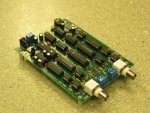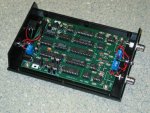> womai's design sounds very useful. Any chance of publishing some/all of it?
Yes, I'll publish all. I just want to be sure everything works and is solid before putting it on the web.
This afternoon I just put together the second revision of the board - had to do it twice because the first PCB had a manufacturing defect (all others of the same batch were fine) that left a sizable area of copper that shouldn't have been there, shorting together power and ground and several other signals

Of course I noticed that fault only AFTER I had assembled and soldered the complete circuit... On the upside, by now I can assemble and solder a complete scope in less than 90min.
The new version now has a real RS-232 port (using a MAX232) which will make it easier to port it to a native PIC when desired, because now it can use the hardware USART. Still a few Picaxe program issues to work out with that interface, my first attempt to use hserin instead of serrxd was only very moderately successful (meaning I received data, but not the one I sent

although hserout works fine through the MAX232.
Other additions are through-hole BNC connectors and a power connector, so for people wanting to spend a minimum amount of money building it a bare-board version is usable (see first attachment). Of course an enclosure makes it look more professional and less geeky

Cost for the bare-board version is around US$50 if you are careful and get about half of the chips as free samples (from Microchip and Maxim). This assumes you build your own PCB (e.g. protoboard) for less than $15, or I manage to get enough people interested to justify a larger batch order from ExpressPCB.
Wolfgang



